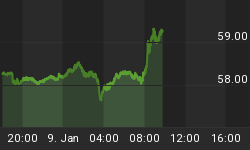There is a blog post on the site of the New York Fed might be significant. The title of the post is "Has the Fed Stabilized the Price Level?" In the post, the authors take up the question of price level targeting. This, in itself, is worth noting because the debate about whether the Fed should target the inflation rate (trying to hit 2% on the PCE deflator every year) or the price level (trying to average 2% over the next 10 years, say) has been ebbing and flowing for the last few years but during and after the crisis has generally taken a back seat to more pressing issues like "how can we buy a couple trillion dollars' worth of Treasury and mortgage-backed securities without impairing market function?" Back at the end of 2010, I wrote a blog post about the fact that price-level targeting is gaining currency (no pun intended) at the Fed.
The authors start by noting that the Fed has been incredibly successful, as it turns out, at hitting the 2% target on inflation. Like most authors who address this subject, they choose a historical period where that happens to be the case and draw a nice exponential curve that happens to fit nicely since, after all, they chose a period during which low and stable inflation was the norm. They then proceed, as most establishment economists do, to give the Fed most if not all of the credit for maintaining inflation low and stable even though any fair real-time analysis of the history - see, for example, my book which, incidentally, makes a fine Christmas gift - must conclude that this was partly a lucky break.
What is interesting and potentially significant, though, is where the authors focus on the deviation from that trend. Although drawing the line the way they originally drew it suggests that the Fed has successfully targeted long-term price-level growth almost exactly, they then re-draw the line based on an arbitrary start date of January 2006 (this happens to be the beginning of Bernanke's tenure, but since the price level in 2006 has nothing to do with actions he took in 2006, that date is purely arbitrary). The significance is that when drawn from that date, the price level appears too low:
"While the price level has remained remarkably close to its 2 percent trend line since the early 1990s, the total PCE deflator has been below this trend line since 2009 with a 1.4 percent gap in July 2013; the core index displays an even larger gap."
Hmmm. At this point, one suspects that the authors may be adjusting the lens to reach the conclusion they want. They proceed to ask whether the Fed is, or should be, aiming to stabilize inflation (at 2% on PCE, about 2.25% on CPI) or the price level, and suggest (remember, the authors are at the Fed) that quantitatively speaking the Fed's policy has worked out to be essentially price-level targeting whatever they called it. The big moment comes:
"Moreover, while the FOMC has stated its policy strategy in terms of an inflation rate and not the price level, it is interesting to note that there is a technical equivalence between the Fed's "longer-run inflation goal" of 2 percent and price-level targeting. As such, if the FOMC's past behavior continues, it is reasonable to expect inflation temporarily higher than 2 percent so that the price level will return to its long-run trend line."
Whether or not the Fed actually chooses, or should choose, price-level targeting or rate targeting is a debate for a future day although the link to my blog post above shows it is also a debate for a past day! The interesting thing about the NY Fed blog post, though, is that the price-level argument is being used to support the notion that inflation somewhat above the target is not only acceptable but actually desirable. This may be merely an academic discussion, but take note of it just in case.
You can follow me @inflation_guy!
Enduring Investments is a registered investment adviser that specializes in solving inflation-related problems. Fill out the contact form at http://www.EnduringInvestments.com/contact and we will send you our latest Quarterly Inflation Outlook. And if you make sure to put your physical mailing address in the "comment" section of the contact form, we will also send you a copy of Michael Ashton's book "Maestro, My Ass!"
















